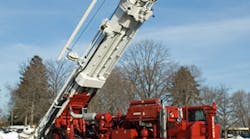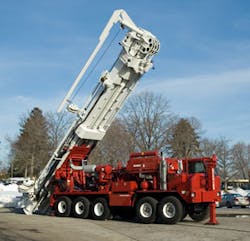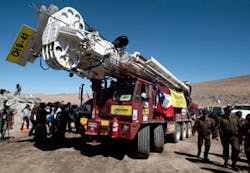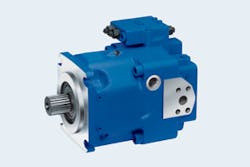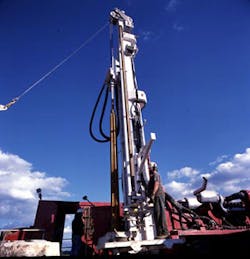Schramm’s T130XD mobile drilling rig, equipped with Rexroth AA11VLO pumps.
Last year, the world watched the drama unfold in a Chilean gold mine, as 33 miners worked together to survive for more than two months whiled trapped underground. As rescuers put plans together to dig down and save them, it was clear that hydraulics would play some part. So it’s no surprise that variable displacement pumps from Bosch Rexroth Corp., Hoffman Estates, Ill., were used to power the Schramm Inc. T130XD mobile drilling rig that eventually bore through the earth and reached the men.
Quick to action
Gold mines are some of the deepest mines in the world. When disasters such as mine collapse occur, the challenge of rescuing anyone trapped below can be monumental. On Aug. 5, a cave-in occurred at the San Jose gold and copper mine near the northern city of Copiapó, Chile, trapping 33 miners about 2300 ft below the surface.
They waited for 17 days until a small bore hole drilled from above reached their location, and the miners attached a message informing the world above that they were still alive. Thus began what would be one of the most thrilling and technologically innovative mine rescues in recent history.
Immediately following the collapse, Chile’s government called in drilling professionals from across the country, and ultimately worldwide, to determine appropriate steps.
Examination of the mine’s layout suggested one possible area where survivors (if any) might gather: a mechanics’ room measuring approximately 538 ft2 — the equivalent of a small apartment — situated 2300 ft down. Drilling a bore hole that deep, with that level of accuracy for the endpoint, was compared to “hitting the head of a pin with a 20-ft pole.”
The mining authorities were also concerned with the local geology: it was known that granite structures at the site were at least 20% harder than granite typically found in the U.S. Drilling consistency would be varied, with densities ranging from low to very high.
Multiple rescue plans
When the Chilean government sent out the call for assistance, it was determined that the T130XD rig, equipped with Rexroth hydraulics, offered several potential advantages for the rescue.
The initial rescue plan, called “Plan A,” developed by the Chilean authorities focused on using a complex drilling rig called a raise borer from another manufacturer, to drill a vertical rescue hole.
The raise borer vertical rig took time for arrival and set up, and required vertical placement precisely over the location of the miners. When the Plan A vertical hole was started on August 30, the miners had been underground for close to a month. It was estimated that drilling would progress at about 66 ft per day, and require 80 days to rescue them — if uninterrupted.
Although they were supplied with food capsules and other supplies through the initial pilot holes, estimates of their release ranging from “60 to 90 days” and “around Christmas” led to alternative plans for drilling rescue holes.
At the time of the San Jose collapse, a Schramm T130XD drilling rig was being operated about 1000 km away, drilling large-diameter bore holes for water extraction at another deep Chilean mine site.
The T130XD is a heavy duty, heavy hoist carrier mounted drill rig designed to provide powerful drilling performance in a compact, all-in-one carrier mounted rig. It features a 760-hp deck engine, and was designed by Schramm for heavy-duty deep drilling applications with up to 130,000 lb of pullback capacity. The T130XD was designed for drilling applications such as shallow oil and gas, deep water wells, geothermal exploration, and deep mine rescue.
A key component of the hydraulic system that powers the Schramm drill are the Rexroth AA11VLO variable displacement axial piston pumps, supplied by local Rexroth distributor Airline Hydraulics Inc., Bensalem, Pa. Schramm selected the Rexroth AA11VLO130 pumps when designing the T130XD because of their proven performance, particularly in deep drilling applications requiring the high pressure capacity and pullback force delivered by the rig.
Schramm’s drill uses four Rexroth AA11VLO130 pumps, which supply hydraulic pressure to the top mast head and mast cylinders. The top mast head is the mechanism at the top of the drill mast that provides the pullback force to manipulate thousands of feet of pipe down the hole; the mast cylinders support this function.
When the Chilean government sent out the call for assistance, it was determined that the T130XD rig, equipped with Rexroth hydraulics, offered several potential advantages for the rescue.
Rexroth’s AA11VLO series of axial piston variable displacements pumps are designed for hydrostatic drives in open circuits. They offer high power capacity and displacement in a compact design, with nominal pressure of 5100 psi (350 bar) and maximum pressure of 5800 psi (400 bar.) The AA11VLO130 is equipped with a charge pump enabling high input speeds, which is especially important at high altitude operation, like Chile. Its 130 cc/rev (7.93 in3/rev) can operate at engine speeds up to 2500 rpm.
When the Chilean government sent out the call across the country for assistance, it was determined that the T130XD rig offered several potential advantages for the rescue:
- The T130XD is well-suited for drilling with reverse-circulation down-the-hole hammers, making it especially ideal for drilling through the Chilean granite.
- Schramm’s rig was designed to drill off a vertical axis, enabling it to utilize one of the existing pilot holes to drill a rescue portal, and would not have to be emplaced directly above the miners.
- The T130XD in Chile was equipped with Schramm’s highest capacity top head, capable of drilling holes up to 28 inches in diameter.
- The T130XD is designed for fast teardowns and relocations, enabling it to make the 1000 km trip in relatively short time.
Given the advantages offered by the T130XD, the Chilean mining authorities developed a “Plan B” rescue plan: the T130XD would enlarge one of the 5.5-in. diameter initial probe holes, drilled with two passes. The first pass would increase its diameter to 12 in. and the second pass to 28 inches diameter, to allow a rescue rig to be lowered.
Putting Plan B into action
The variable displacement pumps on the T130XD supply hydraulic pressure to the top mast head for manipulating thousands of feet of pipe.
T130XDAction4.jpg The AA11VLO130 pumps on the T130XD enable high input speeds, which is especially important for high-altitude operation.
Arriving at the San Jose mine on September 30, the T130XD was quickly set up and drilling on the first pass hole proceeded 24/7. The Schramm rig quickly outpaced the Plan A vertical bore hole rig, and had widened the pilot hole from 5.5 in. to 12 in. along the entire 2260-ft length in a little over two weeks.
According to Schramm officials, the reliable performance of the Rexroth AA11VLO130 pumps was crucial to the speed of the drilling.
“The pumps are mission critical to the T130XD — if the pumps are out of commission, there is no hoist or rotation,” said Brian Brookover, Schramm control systems team leader. “It’s important to note that the Schramm T130XD used for the rescue had zero down time directly attributable to the rig throughout the rescue process. The Rexroth pumps did their part,” he said.
The world watched
Because the Plan B hole being drilled by the Schramm rig was going so much faster than the Plan A hole (which still had not completed its first pass), it appeared increasingly likely that the T130XD hole would be the rescue hole — and that instead of taking until “around Christmas,” the process could be completed by mid-October.
In preparation for its second pass, the T130XD was outfitted with a 12- to 28-in. expansion boring tool. The drilling would continue just as quickly with this larger down-the-hole hammer, which took full advantage of the rig’s high-capacity top head.
Most of the hole drilled by the T130XD was through solid rock; however, the top 300 ft was looser material. It was decided that this would be lined with 24-in. steel casing, to prevent loose rock from falling down the hole and jamming the rescue capsule. The T130XD’s flexible tilt-out head easily handled both the drill pipe and the casing for this safety step.
On October 9, just 33 days after the T130XD began its drilling, the second pass was completed; four days later, as a worldwide audience estimated in the hundreds of millions watched, all 33 miners were safely re-united with their families and communities, and Chile celebrated a miracle under and above the earth.
For more information, visit Bosch Rexroth at www.boschrexroth-us.com; Schramm Inc. at www.schramminc.com, or Airline Hydraulics Inc. at www.airlinehyd.com.
